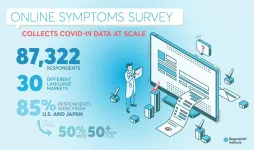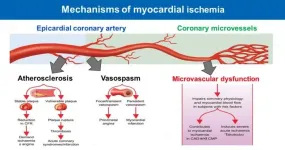The 7-question survey was launched in multiple languages during April 2020, as lockdowns were implemented to slow the spread of COVID-19. A link to the survey was placed in banner ads in Microsoft News articles. Respondents answered questions about experiencing COVID-19 symptoms, testing and their recent travel. The survey was voluntary and anonymous.
The survey captured 87,322 respondents during a three-week period. Responses included people from every U.S. state and nearly every county in each state. 85.2 percent of the respondents were from the U.S. and Japan, and more than half of those were 50 years or older.
"We found this survey method to be feasible for collecting large-scale data from people in the community, enhancing disease surveillance," said study author Brian Dixon, PhD, MPA, director of public health informatics at Regenstrief Institute and IU Richard M. Fairbanks School of Public Health at IUPUI. "The population in this survey skewed older and reflects individuals who participate in traditional opinion surveys. Volunteers come across our call for help while, simply, reading the news. Other social media sites trend younger and draw from individuals constantly bombarded with quizzes and marketing surveys. Furthermore, the news platform we used was able to reach the population who is at higher risk of complications from COVID-19, which is important to monitor and target in public health efforts during this pandemic."
The data gathered is unique because it comes from community residents rather than people who were hospitalized with the disease. The survey revealed several interesting insights about patterns of symptoms. * Those who reported loss of taste or smell and fever, symptoms associated with active SARS-CoV-2 infection, were more likely to have been tested for COVID-19. * Individuals reporting symptoms were more likely to report travelling more than 15 miles from their home within the past two weeks. * Those without symptoms were significantly less likely to report being tested. However, testing infrastructure in the U.S. was limited at the time of the survey. * The number of people reporting symptoms was correlated with the testing rates in U.S. states, indicating that symptom monitoring could be a proxy for testing in places where testing might be limited.
"This approach offers access to a wide audience, many of whom might not be captured in other data gathering methods," said study author Mary L. Gray, PhD, senior principal researcher at Microsoft Research and faculty at Indiana University Luddy School of Informatics, Computing, and Engineering. "This work sheds light on the potential uses of this method for the current pandemic and other circumstances where data gathering at scale is needed quickly."
"Based on our results, online news tools can be a useful strategy for reaching broad and diverse populations during emerging outbreaks. It is a quick and easy way to gather a significant amount of data and appears to accurately capture what is happening in the community at large," said study author Shaun Grannis, M.D., M.S., Regenstrief vice president for data and analytics and IU School of Medicine professor of family medicine. "Combined with other methods, online news tools can help public health organizations quickly assess trends in emerging infections before individuals seek treatment, allowing a faster public health response."
The research team launched a second online survey in December 2020 to expand efforts to track symptoms, understand population behavior, and gather insights on vaccine attitudes.
INFORMATION:
The survey was created in English, translated into 12 additional languages, and released into 30 different language markets.
"Capturing COVID-like Symptoms At-Scale using Banner Ads: A Novel Survey Methodology Pilot using an Online News Platform" was published in the Journal of Medical Internet Research (JMIR).
In addition to Drs. Dixon, Gray and Grannis, authors on the paper are Sumit Mukherjee, PhD, from Microsoft Corporation; Ashley Wiensch, MPH, from Regenstrief Institute; and Juan M. Lavista Ferres, M.S., from Microsoft Corporation.
About Regenstrief Institute
Founded in 1969 in Indianapolis, the Regenstrief Institute is a local, national and global leader dedicated to a world where better information empowers people to end disease and realize true health. A key research partner to Indiana University, Regenstrief and its research scientists are responsible for a growing number of major healthcare innovations and studies. Examples range from the development of global health information technology standards that enable the use and interoperability of electronic health records to improving patient-physician communications, to creating models of care that inform practice and improve the lives of patients around the globe.
Sam Regenstrief, a nationally successful entrepreneur from Connersville, Indiana, founded the institute with the goal of making healthcare more efficient and accessible for everyone. His vision continues to guide the institute's research mission.
About the Richard M. Fairbanks School of Public Health at IUPUI
Located on Indiana's premier research and health sciences campus, the Richard M. Fairbanks School of Public Health at IUPUI is committed to advancing the public's health and well-being through education, innovation and leadership. The Fairbanks School of Public Health is known for its expertise in biostatistics, epidemiology, cancer research, community health, environmental public health, global health, health policy and health services administration.
About IU School of Medicine
IU School of Medicine is the largest medical school in the U.S. and is annually ranked among the top medical schools in the nation by U.S. News & World Report. The school offers high-quality medical education, access to leading medical research and rich campus life in nine Indiana cities, including rural and urban locations consistently recognized for livability.
About Brian E. Dixon, PhD, MPA
In addition to his role as Regenstrief Institute and Indiana University Richard M. Fairbanks School of Public Health at IUPUI director of public health informatics, Brian E. Dixon, MPA, PhD, is a research scientist at Regenstrief and an associate professor of epidemiology at the Fairbanks School of Public Health. He is also an affiliate scientist at the U.S. Department of Veterans Affairs Health Services Research and Development Center for Health Information and Communication, Richard L. Roudebush VA Medical Center.
About Mary L. Gray, PhD
Mary L. Gray, PhD, is senior principal researcher at Microsoft Research and faculty associate at Harvard University's Berkman Klein Center for Internet and Society. She maintains a faculty position in the IU Luddy School of Informatics, Computing, and Engineering with affiliations in anthropology and gender studies.
About Shaun Grannis, M.D., M.S.
In addition to his role as the vice president of data and analytics at Regenstrief Institute, Shaun Grannis, M.D., M.S., is the Regenstrief Chair in Medical Informatics and a professor of family medicine at Indiana University School of Medicine.





